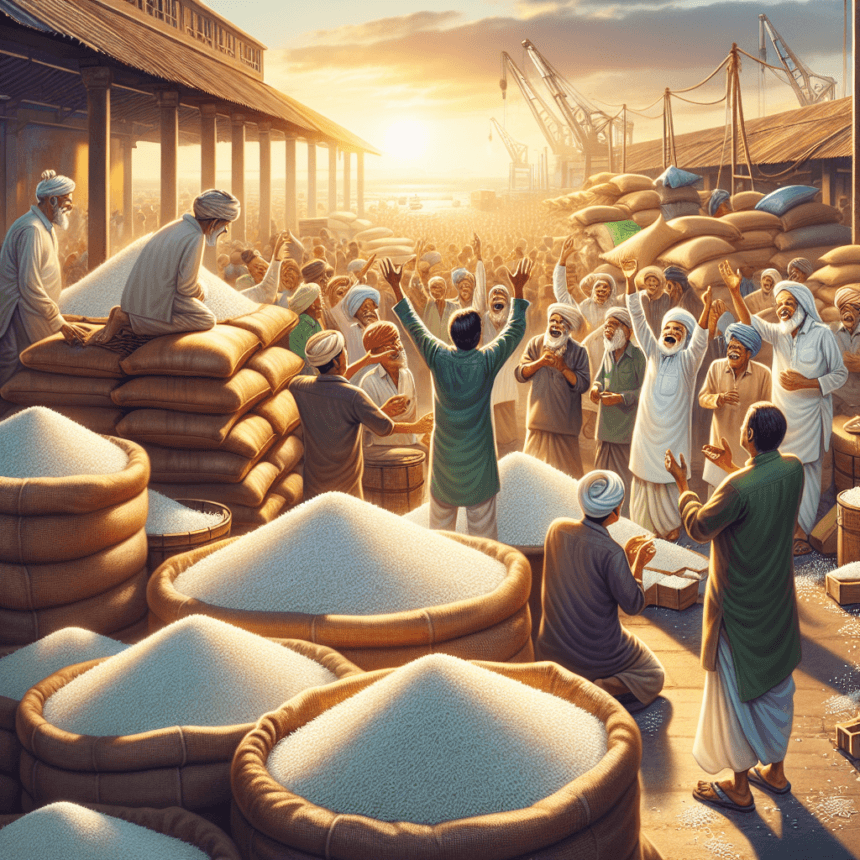Main Points In Hindi (मुख्य बातें – हिंदी में)
यहाँ कुछ मुख्य बिंदु हैं जो पाकिस्तान में जल संकट और कृषि पर इसके प्रभाव का सारांश प्रस्तुत करते हैं:
-
पानी की कमी और कृषि वृद्धि: पाकिस्तान की कृषि वृद्धि के लिए पानी एक महत्वपूर्ण सीमित कारक बन गया है। सतही और भूजल की कमी के कारण, लाखों एकड़ बंजर भूमि का लाभ नहीं उठाया जा सका है।
-
जल भंडारण क्षमता की कमी: पाकिस्तान की जल भंडारण क्षमता लगातार घट रही है। 16.26 मिलियन एकड़-फीट से घटकर यह 13.68 मिलियन एकड़-फीट तक पहुँच गई है, जिससे जल परिवहन की क्षमता केवल 30 दिन रह गई है।
-
जलवायु परिवर्तन के प्रभाव: बढ़ते तापमान के कारण जल चैनलों में वाष्पीकरण की दर में वृद्धि हुई है, जिससे कृषि में पानी की हानि हो रही है। ग्लेशियरों के पिघलने से अल्पावधि में बाढ़ आ सकती है, लेकिन दीर्घकालिक में जल संकट की संभावना बढ़ती जा रही है।
-
भूजल पर निर्भरता: पाकिस्तान वैश्विक भूजल निकासी का 9% योगदान देता है, जो इसे भारत और अमेरिका के बाद तीसरा सबसे बड़ा उपयोगकर्ता बनाता है। 73% क्षेत्र भूजल पर निर्भर है, जिससे प्राकृतिक पुनःपूर्ति पर दबाव पड़ता है।
- जल-उपयोग दक्षता में कमी: पाकिस्तान की सिंचित कृषि जल उपयोग दक्षता अन्य देशों की तुलना में बेहद कम है। बढ़ती सिंचाई लागत और बिजली दरों के प्रभाव ने किसानों के लिए आर्थिक चुनौतियाँ बढ़ा दी हैं। जल-कुशल सिंचाई प्रथाओं को अपनाने की आवश्यकता है ताकि लागत प्रतियोगिता में बने रह सकें।
Main Points In English(मुख्य बातें – अंग्रेज़ी में)
Here are the main points from the provided text about water issues in Pakistan’s agriculture sector:


-
Water Scarcity as a Limiting Factor: Water has become the most critical limiting factor for agricultural growth in Pakistan. Despite having millions of acres of barren land, the inability to expand the cultivated area in the past is attributed to a lack of surface water and poor groundwater quality.
-
Inadequate Water Management and Climate Challenges: Pakistan faces significant challenges related to inadequate water storage capacity, substantial losses in water transport, and inefficient irrigation methods. The country’s water storage capacity has decreased over time, limiting its water supply significantly compared to other countries.
-
Heavy Reliance on Groundwater: With only 3% of the world’s population, Pakistan accounts for about 9% of global groundwater extraction, making it the third-largest user after India and the United States. Approximately 73% of its agricultural land depends directly or indirectly on groundwater, leading to unsustainable extraction rates.
-
Impact of Climate Change: Rising temperatures due to climate change are exacerbating water scarcity, increasing evaporation rates, and impacting agricultural productivity. The consequences include heightened water loss, especially with water-intensive crops like rice, which further pressures the agricultural system.
- Need for Improved Water-Efficient Practices: To address the impending water crisis, Pakistan needs to adopt water-efficient irrigation practices and technologies. Current irrigation methods are highly inefficient, and improving this aspect is crucial for maintaining the economic viability of crops and ensuring food security amid rising water costs.
Complete News In Hindi(पूरी खबर – हिंदी में)
पानी पाकिस्तान की कृषि वृद्धि के लिए सबसे महत्वपूर्ण सीमित कारक बन गया है। लाखों एकड़ बंजर भूमि की उपलब्धता के बावजूद, विशेष रूप से बलूचिस्तान और पंजाब में, सतही और गुणवत्ता वाले भूजल की कमी के कारण अतीत में देश के खेती योग्य क्षेत्र का विस्तार नहीं किया जा सका।
पाकिस्तान में, पानी की कमी एक तेजी से महत्वपूर्ण मुद्दा है, जो अपर्याप्त जल भंडारण क्षमता, जल चैनलों में महत्वपूर्ण परिवहन हानि और खराब जल-उपयोग दक्षता – सिंचाई जल की प्रति इकाई उत्पादित फसल (किलोग्राम या डॉलर में) की जटिल परस्पर क्रिया के कारण उत्पन्न होती है। उपयोग – खेत स्तर पर, मुख्य रूप से बाढ़ सिंचाई जैसी पुरानी सिंचाई पद्धतियों के कारण।
यदि हम आपूर्ति पक्ष को देखें, तो देश के दो सबसे बड़े जल संसाधन – ग्लेशियर और भूमिगत जल – चिंताजनक दर से कम हो रहे हैं। बढ़ते तापमान के कारण हिमालय के ग्लेशियरों के तेजी से पिघलने से अल्पावधि में बाढ़ की बड़ी घटनाएं हो सकती हैं। हालाँकि, लंबे समय में, ग्लेशियरों के काफी सिकुड़ जाने पर इसके परिणामस्वरूप पानी की गंभीर कमी हो जाएगी।
जलवायु परिवर्तन के कारण बढ़े हुए जल प्रवाह का लाभ पाने के लिए पाकिस्तान की पानी की कमी की क्षमता गंभीर रूप से कम है। समय के साथ, देश की जल भंडारण क्षमता धीरे-धीरे 16.26 मिलियन एकड़-फीट (एमएएफ) से घटकर 13.68 एमएएफ रह गई है। परिणामस्वरूप, 2021 तक देश में केवल 30 दिनों की जल परिवहन क्षमता है, जो भारत की 170 दिनों और मिस्र की 700 दिनों की क्षमता के बिल्कुल विपरीत है।
कम भंडारण क्षमता और तनावग्रस्त भूजल जलभृत के साथ, पाकिस्तान को जल-कुशल सिंचाई पद्धतियों को अपनाने की जरूरत है
दुनिया की आबादी का केवल तीन प्रतिशत होने और वैश्विक सकल घरेलू उत्पाद में मात्र 0.36 प्रतिशत योगदान देने के बावजूद, पाकिस्तान दुनिया के कुल भूजल निकासी में आश्चर्यजनक रूप से 9 प्रतिशत का योगदान देता है, जो इसे भारत और संयुक्त राज्य अमेरिका के बाद तीसरा सबसे बड़ा उपयोगकर्ता बनाता है। भूजल पर अनियंत्रित और लगातार बढ़ती निर्भरता – पाकिस्तान का 73 प्रतिशत क्षेत्र प्रत्यक्ष या अप्रत्यक्ष रूप से भूजल पर निर्भर है – ने पाकिस्तान को उन देशों की श्रेणी में धकेल दिया है जहां भूजल निष्कर्षण जलभृतों की प्राकृतिक पुनःपूर्ति से अधिक है।
इसके अलावा, मानव-प्रेरित जलवायु परिवर्तन के कारण पाकिस्तान गर्म हो रहा है, 2010 और 2000 क्रमशः सबसे गर्म और दूसरे सबसे गर्म दशक हैं। औसत तापमान में वृद्धि के अलावा, गर्मी तरंगों की आवृत्ति, अवधि और तीव्रता भी बढ़ रही है।
बढ़ते तापमान ने जल चैनलों में वाष्पीकरण दर में वृद्धि की है और कृषि क्षेत्रों में वाष्पीकरण-उत्सर्जन – वाष्पीकरण और पौधों के वाष्पोत्सर्जन से नष्ट होने वाला पानी – बढ़ गया है।
पानी की ऐसी हानि विशेष रूप से पानी की अधिकता वाली चावल की फसल में अधिक होती है, जहाँ किसान अक्सर कई महीनों तक खेतों में पानी भर कर रखते हैं। पिछले 10 वर्षों में चावल की फसल का रकबा 31 प्रतिशत बढ़ गया है, जो कई कारकों से प्रेरित है, जिसमें इसकी उच्च निर्यात क्षमता, मजबूत स्थानीय मांग और अपेक्षाकृत उच्च रिटर्न के कारण चावल की बेहतर विपणन क्षमता शामिल है। इसके अतिरिक्त, दो अन्य जल-गहन गन्ना और मक्का के फसल क्षेत्र में भी हाल के वर्षों में काफी विस्तार हुआ है।
दुनिया के कुल भूजल निकासी में पाकिस्तान का हिस्सा 9% है, जो भारत और संयुक्त राज्य अमेरिका के बाद तीसरा सबसे बड़ा उपयोगकर्ता बन गया है।
जनसंख्या विस्फोट के कारण, खाद्य सुरक्षा पाकिस्तान के लिए एक गंभीर चुनौती बनती जा रही है, जिसका जवाब इनपुट-सघन खेती, कृषि भूमि के विस्तार और फसल गहनता में वृद्धि के माध्यम से दिया जा रहा है। हालाँकि, इन रणनीतियों के लिए अतिरिक्त पानी की आवश्यकता होती है, जिससे कम पानी में अधिक उत्पादन करने के लिए हमारी सिंचाई प्रणाली पर तीव्र दबाव पड़ता है।
संक्षेप में, पाकिस्तान के कृषि क्षेत्र में पानी की मांग बढ़ रही है, जबकि पानी की आपूर्ति लगातार अनिश्चित होती जा रही है। इस बीच, पानी की हानि और सिंचाई अक्षमताएँ असाधारण रूप से अधिक बनी हुई हैं।
पाकिस्तान ने विश्व बैंक और अन्य अंतर्राष्ट्रीय विकास भागीदारों से आसान ऋणों द्वारा वित्त पोषित नहरों, वितरिकाओं और जलस्रोतों की लाइनिंग के माध्यम से जल परिवहन के नुकसान को कम करने में महत्वपूर्ण प्रगति की है। 1970 के दशक के दौरान शुरू की गई ये मेगापरियोजनाएं अभी भी प्रांतीय सिंचाई और कृषि विभागों के वार्षिक विकास कार्यक्रमों के तहत चल रही हैं।
हालाँकि, कृषि स्तर पर जल-उपयोग दक्षता एक महत्वपूर्ण क्षेत्र है जहाँ पाकिस्तान काफी पीछे है। जैसा कि संयुक्त राष्ट्र के खाद्य और कृषि संगठन द्वारा रिपोर्ट किया गया है, पाकिस्तान की सिंचित कृषि जल उपयोग दक्षता – सतत विकास लक्ष्य 6.4.1 – बांग्लादेश, भारत और चीन जैसे देशों की तुलना में 2021 में बेहद कम, औसतन केवल $0.40 प्रति घन मीटर है। यह क्रमशः $0.98, $0.49, और $2.51 प्रति घन मीटर है।
इसके अलावा, कम जल-उपयोग दक्षता के कारण किसानों पर कृषि ट्यूबवेलों के लिए बिजली दरों का प्रतिकूल प्रभाव और भी बढ़ गया है। परिणामस्वरूप, फसलों की समग्र लागत संरचना में सिंचाई सबसे बड़ा लागत कारक बन गया है, जिससे पाकिस्तान की फसलों की आर्थिक व्यवहार्यता काफी कम हो गई है।
पानी की खपत से समझौता किए बिना सिंचाई लागत कम करने के लिए बड़ी संख्या में किसान सौर ऊर्जा से संचालित ट्यूबवेलों की ओर रुख कर रहे हैं। हालाँकि, सूरज की रोशनी की सीमित उपलब्धता के कारण ये प्रणालियाँ अभी तक ग्रिड-संचालित प्रणालियों के रूप में विश्वसनीय विकल्प साबित नहीं हुई हैं, जो कि बादल, कोहरे और धुंध जैसी मौसम की स्थितियों से और भी अधिक बाधित होती है।
निष्कर्षतः, पाकिस्तान का आसन्न जल संकट, पानी की बढ़ती कीमतों के साथ मिलकर, जल-कुशल सिंचाई प्रथाओं को अपनाने और ड्रिप, रेन गन जैसी उच्च दक्षता वाली सिंचाई प्रणालियों के व्यापक उपयोग के माध्यम से जल-उपयोग दक्षता को बढ़ाना अनिवार्य बना देता है। स्प्रिंकलर, और धुरी। इन उपायों की तात्कालिकता कभी इतनी अधिक नहीं रही, क्योंकि वे आज पाकिस्तान के कृषि क्षेत्र की लागत प्रतिस्पर्धात्मकता को बनाए रखने के लिए आवश्यक हैं, यदि सुधार नहीं कर रहे हैं।
चौधरी मोहम्मद अशरफ पंजाब कृषि विभाग के पूर्व महानिदेशक (ऑन-फार्म जल प्रबंधन) हैं, और खालिद वट्टू एक किसान और विकास पेशेवर हैं।
डॉन, द बिजनेस एंड फाइनेंस वीकली, 30 सितंबर, 2024 में प्रकाशित
Complete News In English(पूरी खबर – अंग्रेज़ी में)
Water has become the most critical limiting factor for agricultural growth in Pakistan. Despite having millions of acres of barren land, particularly in Balochistan and Punjab, the country has struggled to expand its arable land due to a shortage of surface water and groundwater quality.


Water scarcity is increasingly becoming a significant issue in Pakistan, stemming from inadequate water storage capacity, significant transportation losses in water channels, and poor water-use efficiency—specifically the complex interrelation of irrigation water per unit of crop yield (measured in kilograms or dollars). This inefficiency is largely due to outdated irrigation practices, such as flood irrigation.
On the supply side, the country’s two main water resources—glaciers and groundwater—are rapidly depleting. Rising temperatures are causing Himalayan glaciers to melt more quickly, leading to potential flooding in the short term. However, in the long term, the significant shrinkage of these glaciers could result in severe water shortages.
Pakistan’s capacity to benefit from increased water flow due to climate change is critically low. Over time, the country’s water storage capacity has gradually declined from 16.26 million acre-feet (MAF) to 13.68 MAF. Consequently, by 2021, Pakistan had only 30 days of water transport capacity, compared to India’s 170 days and Egypt’s 700 days.
With limited storage capacity and stressed groundwater sources, Pakistan must adopt water-efficient irrigation practices.
Despite comprising only three percent of the world’s population and contributing a mere 0.36 percent to the global GDP, Pakistan astonishingly accounts for 9 percent of the world’s total groundwater extraction, making it the third-largest user after India and the United States. The country’s increasing dependence on groundwater—73 percent of its area relies directly or indirectly on it—places it among nations where withdrawal rates exceed natural replenishment.
Moreover, due to human-induced climate change, Pakistan is heating up; the years 2010 and 2000 are recorded as the hottest and second hottest decades respectively. In addition to a rise in average temperatures, the frequency, duration, and intensity of heat waves are also increasing.
The rise in temperature has led to an increase in evaporation rates in waterways and evapotranspiration in agricultural fields, which refers to the loss of water through evaporation and plant transpiration.
This water loss is particularly high for rice crops, which require farmers to flood fields for several months. Over the past decade, the area under rice cultivation has expanded by 31 percent, driven by its high export potential, strong domestic demand, and relatively high profitability. Additionally, the cultivation of other water-intensive crops like sugarcane and corn has also significantly increased in recent years.
Due to a population explosion, food security is becoming a serious challenge for Pakistan, which is being addressed through input-intensive farming, expansion of agricultural land, and increased crop intensity. However, these strategies require additional water, putting intense pressure on the irrigation system to produce more with less water.
In summary, the demand for water in Pakistan’s agricultural sector is rising while water supply is becoming increasingly uncertain. Meanwhile, water loss and inefficiencies in irrigation remain extraordinarily high.
Pakistan has made significant progress in reducing water transport losses through the funding of canal lining, distributaries, and water bodies via easy loans from the World Bank and other international development partners. These mega-projects, which began in the 1970s, are still ongoing under the annual development programs of provincial irrigation and agriculture departments.
However, at the farm level, water-use efficiency is an area where Pakistan is lagging. According to the Food and Agriculture Organization of the United Nations, Pakistan’s irrigation water-use efficiency—Sustainable Development Goal 6.4.1—was only $0.40 per cubic meter in 2021, significantly lower than that of Bangladesh, India, and China, which had efficiencies of $0.98, $0.49, and $2.51 per cubic meter, respectively.
Furthermore, low water-use efficiency has adversely affected farmers due to rising electricity costs for agricultural tube wells. As a result, irrigation has become the largest cost component in the overall cost structure of crops, severely affecting the economic viability of farming in Pakistan.
To reduce irrigation costs without compromising water consumption, many farmers are turning to solar-powered tube wells. However, due to limited sunlight availability, these systems currently do not offer a reliable alternative compared to grid-powered systems, which are further disrupted by weather conditions like clouds, fog, and mist.
In conclusion, Pakistan’s looming water crisis, coupled with rising water costs, makes it essential to improve water-use efficiency through the adoption of water-efficient irrigation practices and the widespread use of high-efficiency irrigation systems such as drip, rain guns, sprinklers, and pivots. The urgency for these measures has never been greater, as they are essential for maintaining the cost competitiveness of Pakistan’s agricultural sector, if not improving it.
Chaudhry Mohammad Ashraf is the former Director General (On-Farm Water Management) of the Punjab Agriculture Department, and Khalid Wattoo is a farmer and development professional.
Published in Dawn, The Business and Finance Weekly, September 30, 2024








